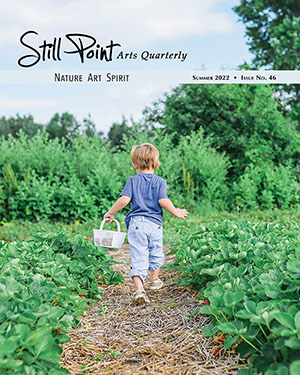 Still Point Arts Quarterly is a print publication of the Still Point Art Gallery of Brunswick, Maine. The gallery also features an online exhibit space. The current exhibit, Blue: Color of the Clear Blue Sky and the Deep Sea, can be viewed in the online gallery and will be a featured exhibition through February 28, 2015. The current print publication has beautiful, full-color reproductions of select images from the exhibit, including best in show for portfolio (Louis Ebarb), best in show for a single image (Sheri Marcus), bets in photography (Marko Susla), best painting or drawing (Roberta Dixon), and best mixed-media artwork (Ellen Kalin). Song by Zoey Frank is pictured on the publication’s cover.
Still Point Arts Quarterly is a print publication of the Still Point Art Gallery of Brunswick, Maine. The gallery also features an online exhibit space. The current exhibit, Blue: Color of the Clear Blue Sky and the Deep Sea, can be viewed in the online gallery and will be a featured exhibition through February 28, 2015. The current print publication has beautiful, full-color reproductions of select images from the exhibit, including best in show for portfolio (Louis Ebarb), best in show for a single image (Sheri Marcus), bets in photography (Marko Susla), best painting or drawing (Roberta Dixon), and best mixed-media artwork (Ellen Kalin). Song by Zoey Frank is pictured on the publication’s cover.
NewPages Blog
At the NewPages Blog readers and writers can catch up with their favorite literary and alternative magazines, independent and university presses, creative writing programs, and writing and literary events. Find new books, new issue announcements, contest winners, and so much more!
Gift Idea :: SIGNED Poetry Broadsides
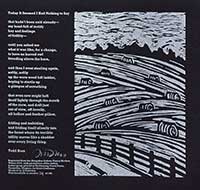 Here’s a great holiday gift for any poetry lover on your list: limited edition, (some) signed poetry broadsides from The Hampden-Sydney Poetry Review. I can personally attest to the quality of these beautiful, limited edition, letterpress (some of handmade papers) editions – having purchased a number of them at past AWP conferences. These are absolute collectibles and will definitely impress. Period. End of story. Order now to get them in time – but even late, they’re worth the wait (for one, there is a pre-order for July delivery).
Here’s a great holiday gift for any poetry lover on your list: limited edition, (some) signed poetry broadsides from The Hampden-Sydney Poetry Review. I can personally attest to the quality of these beautiful, limited edition, letterpress (some of handmade papers) editions – having purchased a number of them at past AWP conferences. These are absolute collectibles and will definitely impress. Period. End of story. Order now to get them in time – but even late, they’re worth the wait (for one, there is a pre-order for July delivery).
Spread the word!
Hellos & Goodbyes at Concho River Review
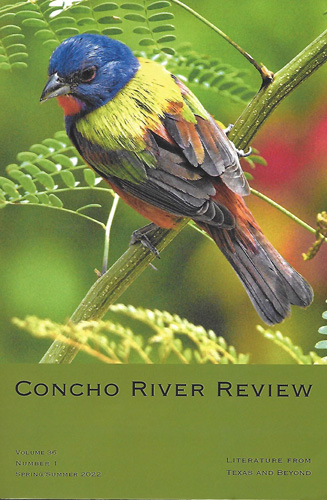 As noted in the Fall 2014 Forward of Concho River Review, “A forward has become a rare occurrence in CRR, and its appearance in an issue signals changes afoot in the journal. There have been a few.” General Editor R. Mark Jackson goes on to explain that Erin Ashworth-King has stepped down as General Editor to assume responsibility’s in the university’s English department. She’ll be phasing out her role over the next several issues. At the same time, Carol Reposa, nonfiction editor since 2008, has resigned and handed over her role to Albert Haley, Writer in Residence at Abilene Christian University since 1997 and author of numerous works published in the likes of The New Yorker, The Atlantic Monthly, and Rolling Stone.
As noted in the Fall 2014 Forward of Concho River Review, “A forward has become a rare occurrence in CRR, and its appearance in an issue signals changes afoot in the journal. There have been a few.” General Editor R. Mark Jackson goes on to explain that Erin Ashworth-King has stepped down as General Editor to assume responsibility’s in the university’s English department. She’ll be phasing out her role over the next several issues. At the same time, Carol Reposa, nonfiction editor since 2008, has resigned and handed over her role to Albert Haley, Writer in Residence at Abilene Christian University since 1997 and author of numerous works published in the likes of The New Yorker, The Atlantic Monthly, and Rolling Stone.
Spread the word!
Lit Mag Covers :: Picks of the Week

There is just something I can appreciate from such an austre image on the front of a magazine – the kind that draws me in, though I can’t quite say why, and makes it hard to look away. This image on the cover of Brick #94 is a photograph of East Jerusalem street scene by Teju Cole. Though it looks black and white, it is in full color.
 I selected this cover image on Green Mountains Review (v27 n2) because the artist, Nancy Dwyer, is featured within the publication as well with a portfolio entitled, “Words are the Furniture of the Mind.” Eight full-color images are featured in addition to this cover.
I selected this cover image on Green Mountains Review (v27 n2) because the artist, Nancy Dwyer, is featured within the publication as well with a portfolio entitled, “Words are the Furniture of the Mind.” Eight full-color images are featured in addition to this cover.
 It was both the image and the opening editorial lines that drew me to this issue of The Molotov Cocktail: “Issue 5.17 will drag you to Hell.” Okay, I’m game. Self-defined as “A Projectile for Incendiary Flash Fiction,” the publication is produced by Josh Goller.
It was both the image and the opening editorial lines that drew me to this issue of The Molotov Cocktail: “Issue 5.17 will drag you to Hell.” Okay, I’m game. Self-defined as “A Projectile for Incendiary Flash Fiction,” the publication is produced by Josh Goller.
Spread the word!
The Westchester Review – 2013
Writing is ordinarily a solitary pursuit, but the result of all that lonely work makes us part of a proud community. The Westchester Review takes the concept of community very seriously, collecting the poetry and prose composed by “established and emerging writers living, working, or studying in New York State’s Westchester County area.” Founder JoAnn Duncan Terdiman and managing editor Naomi L. Lipman tap a deep pool of talent, offering us some very good work that manages to transcend the geographic limits of its submissions policy. Continue reading “The Westchester Review – 2013”
Spread the word!
Skidrow Penthouse – 2014
The title Skidrow Penthouse evokes images of grit. A cover photo featuring bird heads and faceless, female nudes immediately confronts readers with the promise of grit. The 200+ pages of varied writing paired with black and white art neither disappoint, nor fall short of those gritty suggestions. The entire volume is a pleasure to navigate, but the words are not always nice. Continue reading “Skidrow Penthouse – 2014”
Spread the word!
North Carolina Literary Review – 2014
The North Carolina Literary Review is serious business, filled with substantial articles, interviews, poems, and stories that will be cited and remembered beyond the pleasure of reading that so many good literary journals offer. Moreover, there is a welter of photographs and art work, almost too much to take in. This is not an issue to pass on to a friend, but rather to shelve in one’s permanent library. Continue reading “North Carolina Literary Review – 2014”
Spread the word!
upstreet – 2014
Speaking in this issue’s long-form interview with upstreet editor Vivian Dorsel, Pulitzer Prize-winning fiction writer Robert Olen Butler had this to say about the special problems the writer’s medium presents: “The medium for a writer is words, and the words make sounds, but those sounds are immediately overwhelmed by meaning. We are the only artists whose medium is not innately and irreducibly sensual, and yet, as artists, we try to create sensual objects from it. Our medium is constantly struggling with us, to drag us into our heads.”
Spread the word!
The Florida Review – 2014
This double issue of The Florida Review packs in a dazzling array of thought-provoking reading. It invites with accessible forms and quotidian subjects, and rewards with more challenging and experimental material. It covers a vast range of the human experience: what is it like, and what does it mean, to be a woman, a Mormon, a Jew, a person aware of the nearness of death, a person pondering her relationship to her vocation? Continue reading “The Florida Review – 2014”
Spread the word!
Arroyo Literary Review – Spring 2014
At the end of the day, aren’t we all looking for the same thing: words on a page that are strong enough to transport us inside a writer’s mind? I’m a picky reader and I’m sure I’m not the only one. It takes a lot to get, much less keep, our attention. That said, the Spring 2014 issue of Arroyo does not disappoint; in fact, it is quite the page turner—transported I wanted, transported I got. Continue reading “Arroyo Literary Review – Spring 2014”
Spread the word!
Pembroke Magazine – 2014
Dysfunctional families, human nature, and the forces of Mother Nature are all prominent topics in this issue of Pembroke Magazine. While stories with happy endings, delivered with bows on top, are often sought after in today’s culture, it is refreshing and entertaining to read essays, stories, and poetry that have no real resolution. Continue reading “Pembroke Magazine – 2014”
Spread the word!
The Lindenwood Review – 2014
Beth Mead, the editor of The Lindenwood Review, asserts that “the pieces we’ve selected this year are fragmented, showing us moments caught and suspended for our study, helping us find some truths about life through an unexpected point of view.” The Lindenwood Review most certainly holds true to Mead’s statement as each work within the magazine not only enticed me to read its content, but drew me to a level of self-reflection that left me wonderstruck.
Spread the word!
Atlanta Review – Spring/Summer 2014
An out-of-this-country experience, the Atlanta Review introduces a collection of poems that touches on issues of race and bias. In this issue, readers are taken on a tour of Pakistan as they discover a unity in life’s tragedies. Continue reading “Atlanta Review – Spring/Summer 2014”
Spread the word!
Pacifica Literary Review – Summer 2014
Pacifica Literary Review embraces stories dealing with concepts that represent the reality of the world in which they are written. This is evident in the poetry, prose, and art of this issue. The things people wish they could say, or experiences that they may have had but never talk about, find their way onto the page in bold, eye-catching print. Individual poems, stories, and images work together to form a collective narrative of the ever-changing world in which we live. Continue reading “Pacifica Literary Review – Summer 2014”
Spread the word!
Quiddity – Spring/Summer 2014
This Spring/Summer 2014 issue of Quiddity is ambrosia to modern writers and readers alike. It values brevity, and wraps life’s enigmas in eloquent vocabulary. Three-quarters of the issue is dedicated exclusively to poetry, but even the prose is concise, and yet all of the pieces are dense with dimension and meaning. This issue is broken into four categories: poetry, prose, interviews, and art. Each section is carefully pieced together like patches to create a beautiful quilt. Continue reading “Quiddity – Spring/Summer 2014”
Spread the word!
The Meadow – 2014
Never have I felt a literary magazine embody its name more than the current issue of The Meadow. Its contents guide readers through a field of language which sets forth a landscape of natural beauty that’s not without its seasonal allergies. The Meadow amalgamates previously published writers like Keith Dunlap with students, such as Kirsten Jachimiak, who attend Truckee Meadows Community College where the magazine is published. Continue reading “The Meadow – 2014”
Spread the word!
The Common – Fall 2014
I haven’t reviewed many literary journals despite my sixty-something years on earth, since many of those years were spent in the Navy and at sea. I’ve never read a journal cover-to-cover until I perused the Fall 2014 issue of The Common, a relatively new journal, first published in 2011, and headquartered at Amherst College. And I didn’t expect it to make me feel like this was my journal; like I’d selected all of the pieces I want to find in a journal: fiction, poetry, essays, and photography. Continue reading “The Common – Fall 2014”
Spread the word!
The Carolina Quarterly – Summer 2014
According to the cover, the Summer 2014 edition of The Carolina Quarterly is said to be full of “fairy tales, and pheromones, pious knives and lullabies, plus dust, dreams and winged messengers,” but it’s also chock full of darkness and hope, especially in the fiction and nonfiction entries. The Summer 2014 edition takes readers on a roller-coaster ride of loss, love, and optimism. Continue reading “The Carolina Quarterly – Summer 2014”
Spread the word!
The “Think-Feel” of Writing
 Melissa R. Sipin, winner of the 2013 Glimmer Train Fiction Open, offers a craft essay in the Glimmer Train Bulletin #95 entitled “To My Unknown Daughter: On the Inheritance of Writing.” Sipin writes raw what so many writers struggle through in coming to their craft – their work – of writing, “I know, if you are anything like me, you will fight with society like a lover. In your writing, your art, you will need to expose its unwillingness to witness its oppression, its loneliness, its refusal to see truth and its addiction to shadows. And if you are anything like me, the world outside, which is both beautiful and not, both loving and not, both happy and sad, will force you to be sensitive to its pangs and joys, allowing you to think-feel. What is to think-feel?” And then later answers with, “This sensitivity, this ability to think-feel is what makes us writers, the kind of writers with the disposition to know and feel the most extreme states of the human condition (birth, love, and death). And it is because of this that we enter into these liminal spaces alone. We suffer these extreme states to know what loneliness feels like, what sadness, happiness, trauma, and hope are, both in body, mind, and spirit.”
Melissa R. Sipin, winner of the 2013 Glimmer Train Fiction Open, offers a craft essay in the Glimmer Train Bulletin #95 entitled “To My Unknown Daughter: On the Inheritance of Writing.” Sipin writes raw what so many writers struggle through in coming to their craft – their work – of writing, “I know, if you are anything like me, you will fight with society like a lover. In your writing, your art, you will need to expose its unwillingness to witness its oppression, its loneliness, its refusal to see truth and its addiction to shadows. And if you are anything like me, the world outside, which is both beautiful and not, both loving and not, both happy and sad, will force you to be sensitive to its pangs and joys, allowing you to think-feel. What is to think-feel?” And then later answers with, “This sensitivity, this ability to think-feel is what makes us writers, the kind of writers with the disposition to know and feel the most extreme states of the human condition (birth, love, and death). And it is because of this that we enter into these liminal spaces alone. We suffer these extreme states to know what loneliness feels like, what sadness, happiness, trauma, and hope are, both in body, mind, and spirit.”
The Glimmer Train Bulletin is a free monthly that features craft essays from writers published in recent issues of Glimmer Train Stories. Also included in #95 are essays by Selena Anderson (“Want”), George Saunders (“On the Preconceptual World”), and Rowena Macdonald (“Writing Dialogue”). Read them all here.
Spread the word!
Free Stuff :: The Best of the Rag
 If you’re looking to read from an independent, writing a bit on the gritty and grimy side, cutting-edge, and fresh – all words Editors Seth Porter and Dan Reilly use to describe The Rag, then you’ll want to get The Best of The Rag for free! Here are gathered 11 of the editors’ favorite stories from first five issues of The Rag. Download The Best of The Rag here, available in three different formats: PDF, EPUB and Kindle. Cover and featured art by Alex Eckman-Lawn.
If you’re looking to read from an independent, writing a bit on the gritty and grimy side, cutting-edge, and fresh – all words Editors Seth Porter and Dan Reilly use to describe The Rag, then you’ll want to get The Best of The Rag for free! Here are gathered 11 of the editors’ favorite stories from first five issues of The Rag. Download The Best of The Rag here, available in three different formats: PDF, EPUB and Kindle. Cover and featured art by Alex Eckman-Lawn.
The Rag editors encourage good reading, and for writers who are considering submitting, “it’s always wise to first read some of the material we’ve published in the past, so you can get a feel for the tone of our magazine. So before you commit to submitting, grab this free issue. We accept submissions online via Submittable and through the regular mail.”
Spread the word!
Versal Brings Diversity to AWP 2015
Just when you thought the AWP bookfair had all it could offer readers, writers, teachers, and publishers, Megan Garr of the Amsterdam-based Versal, will be presenting a the first-ever display of European presses at AWP 2015.
For the first time in AWP history, bookfair visitors will be able to get their hands on some of Europe’s most innovative and exciting journals and books at this “European Press Table.”
Versal’s table (#432) will transform into a mini-bookfair of over a dozen English-language presses from across Europe:
Readux Books, Berlin
Color Treasury, Paris
MIEL Books, Ghent
VLAK, Prague
Belleville Park Pages, Paris/London
SAND Journal, Berlin
Corrupt Press, Luxembourg
Paris Lit Up, Paris
Teller Magazine, Berlin/London
ESC, Ireland/Belgium
Broken Dimanche, Berlin
EstepaEditions, Paris
Book Ex Machina, Cyprus
Structo, UK
Jess, Estonia
Versal, Amsterdam
Spread the word!
Lit Mag Covers :: Picks of the Week

This issue of Banipal: Magazine of Modern Arab Literature, features a celebration of Saadi Youssef, beginning with this striking portrait on the cover painted by Mansour Mansour.

This cover image on Carbon Culture Review: Techology + Literature + Art is certainly an eye-catcher for its debut issue. Patricia Piccinini’s “The Strength of One Arm (With Canadian Mountain Goat)” is composed of silicone, fiberglass, human hair, clothing, and – yes – Canadian Mountain Goat.
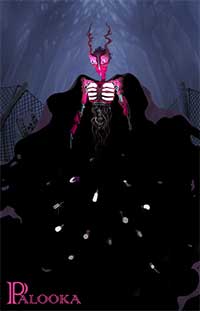
Palooka‘s newest issue (#5) features “Our Bright New Hope” by artist Florian Bo. The theme of light in the dark a fitting one as we approach the longest night of the year – winter solstice.
Spread the word!
Atlanta Review Poetry Issue
The Fall/Winter 2014 issue of Atlanta Review is the Poetry 2014 issue, featuring just under 50 poets and just over 50 poems. Of these, 22 of the poets and their poems were selected for the International Publication Prize from the journal’s annual contest. And one selected above all others as the Grand Prize winner: Joyce Meyers.
Each Fall Issue includes at least 20 Publication Prize winners from their International Poetry Competition with one named for the grand prize cash award of $1000. Every Spring Issue of Atlanta Review includes an International Feature with poets from a different country or continent. The feature for spring 2015: Russia.
Spread the word!
Glimmer Train Family Matters Winners :: 2014
Glimmer Train has just chosen the winning stories for their September Family Matters competition. This competition is held twice a year and is open to all writers for stories about family of all configurations. The next Family Matters competition will take place in March. Glimmer Train’s monthly submission calendar may be viewed here.
 First place: Rowena Macdonald, of London, UK, wins $1500 for “My Brother Is Back.” Her story will be published in Issue 96 of Glimmer Train Stories. [Photo credit: Martin Fuller.]
First place: Rowena Macdonald, of London, UK, wins $1500 for “My Brother Is Back.” Her story will be published in Issue 96 of Glimmer Train Stories. [Photo credit: Martin Fuller.]
Second place: Joshua Graber, of Canton, OH, wins $500 for “Freeman Göttschall Experiences One or Two More or Less Improbably Events.” His story will also be published in an upcoming issue of Glimmer Train Stories, increasing his prize to $700.
Third place: Janet Kim, of Cambridge, MA, wins $300 for “Teeth.”
A PDF of the Top 25 winners can be found here.
Spread the word!
Sierra Nevada Young Writers Contest Winners
Sierra Nevada College’s English Program has released the winners of the 5th annual High School Writing Contest, a national competition which honors high school juniors and seniors in three categories: creative nonfiction, fiction and poetry. The winners in each category receive a cash prize of $500 for first place, $250 for second and $100 for third, and the $100 Local’s Prize honors student writers from Nevada and California. The winners also receive a $20,000 scholarship offer from SNC and consideration for publication in the Sierra Nevada Review, a literary annual which publishes poetry, fiction, and nonfiction by emerging and nationally recognized authors.
The Winners
Creative Nonfiction
First Place: Lindsay Emi (Westlake Village, CA), “Latin Class in Seven (VII) Parts”
Second Place: Darla Macel Anne Canales (Erie, CO), “Oven”
Third Place: Gabriel Braunstein (Arlington MA), “Family on the Commuter Rail”
Local’s Prize: Isabella Stenvall (San Luis Obispo CA), “Wars with Numbers”
Finalists: Emily Zhang, Oriana Tang, Aletheia Wang, Jack Priessman, Annie Harmon
Fiction
First Place: Emily Zhang (Boyds MA), “Midwestern Myth”
Second Place: Lucy Silbaugh (Wyncote PA), “Burrowing”
Third Place: Laura Ingram (Disputanta VA), “Absolute Value”
Local’s Prize: Erin Stoodley (Ventura CA), “Ghosts”
Finalists: Lindsay Emi, Jessica Li, Tatiana Saleh, Madison Hoffman, Oriana Tang
Poetry
First Place: Oriana Tang (Livingston NJ), “Bildungsroman”
Second Place: Catherine Valdez (Miami FL), “Mami”
Third Place: Ruohan Miao (Chandler AZ), “Dust Bowl”
Local’s Prize: Ava Goga (Reno NV), “Notes on Repression”
Finalists: Emily Zhang, Katia Kozachok, Allie Spensley, Emma Symmonds, Jessica Prescott
Spread the word!
CFS :: New World Literature Journal
 Founded by Alexandra Berlina, Department of American Studies, University of Duisburg-Essen, Readings: A Journal for Scholars and Readers is accepting submissions for its inaugural issue.
Founded by Alexandra Berlina, Department of American Studies, University of Duisburg-Essen, Readings: A Journal for Scholars and Readers is accepting submissions for its inaugural issue.
“Readings is a new peer-reviewed journal in literary studies intended to be read by both scholars and the general public. Like other journals, we look for academic quality and originality. Unlike most, we also care for high readability and the potential interest of literature-loving non-scholars. We welcome submissions on all aspects of world literature (be it canonical or contemporary, children’s, ‘genre’ or ‘literary’ fiction), including the interplay of literature and other media as well as issues of translation and reception. Imagine a friend who loves literature but is no scholar as your ideal reader. To put it more grandly: our idea of a Perfect Paper hovers between PMLA and The New Yorker.”
Spread the word!
American Life in Poetry :: Stuart Kestenbaum
American Life in Poetry: Column 505
BY TED KOOSER, U.S. POET LAUREATE
Stuart Kestenbaum is a Maine poet with a new book, Only Now, from Deerbrook Editions. In it are a number of thoughtful poems posed as prayers, and here’s an example:
Prayer for Joy
What was it we wanted
to say anyhow, like today
when there were all the letters
in my alphabet soup and suddenly
the ‘j’ rises to the surface.
The ‘j’, a letter that might be
great for Scrabble, but not really
used for much else, unless
we need to jump for joy,
and then all of a sudden
it’s there and ready to
help us soar and to open up
our hearts at the same time,
this simple line with a curved bottom,
an upside down cane that helps
us walk in a new way into this
forest of language, where all the letters
are beginning to speak,
finding each other in just
the right combination
to be understood.
American Life in Poetry is made possible by The Poetry Foundation (www.poetryfoundation.org), publisher of Poetry magazine. It is also supported by the Department of English at the University of Nebraska-Lincoln. Poem copyright ©2014 by Stuart Kestenbaum, “Prayer for Joy” from Only Now, (Deerbrook Editions, 2014). Poem reprinted by permission of Stuart Kestenbaum and the publisher. Introduction copyright © 2014 by The Poetry Foundation. The introduction’s author, Ted Kooser, served as United States Poet Laureate Consultant in Poetry to the Library of Congress from 2004-2006. We do not accept unsolicited manuscripts.
Spread the word!
Remembering James Foley
 Meat for Tea editor Elizabeth MacDuffie has dedicated the opening pages of the most recent issue (v8 n3) in memory of Jim Foley.
Meat for Tea editor Elizabeth MacDuffie has dedicated the opening pages of the most recent issue (v8 n3) in memory of Jim Foley.
MacDuffe writes, “I remember him thusly: Jim came into the [UMass] grad English program a few years after I did. He was in the MFA program and I was in the Ph.D. program, but his was a pleasant presence in the hallways, and we discussed lesson plans and teaching ideas on a number of occasions. I knew him to be a thoughtful, caring, teacher and a smiling, kind, person. I was more of a friend of friend to him . . . Still, I knew him well enough to admire his courageous actions and to be devastated by his violent, untimely death. I can only imagine the pain his family is enduring and I humbly hope that giving them an issue of the magazine celebrating the man he was helps ease their pain in some small way.”
Writers contributing to the memorial include Molly Crabapple, Samantha Wood, Cathy K. Schlund-Vials, Connolly Ryan Tracy Cummings, Tom Kealey, and Kristin Bock.
Spread the word!
Call for Poems :: Broadsided Groundsourced Anthology
From the Editorial Team at Broadsided:
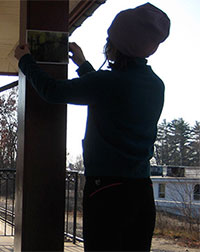 We hope you are feeling deeply connected to the things in your lives for which you are grateful. Among our many gratitudes is that Broadsided is a responsive entity, developing its interactions with the world as situations arise. The events in Ferguson, Missouri have, as we all know, radiated outward to touch upon deep issues in American culture. Race, power, violence, justice, and questions of how we can create and maintain a society that is just and safe for all its citizens.
We hope you are feeling deeply connected to the things in your lives for which you are grateful. Among our many gratitudes is that Broadsided is a responsive entity, developing its interactions with the world as situations arise. The events in Ferguson, Missouri have, as we all know, radiated outward to touch upon deep issues in American culture. Race, power, violence, justice, and questions of how we can create and maintain a society that is just and safe for all its citizens.
We have seen powerful poems offered in response–by writers of those poems themselves and also by those looking for voices to help them speak. We want to help gather and honor those voices. To do so, we have launched a new initiative: Groundsourced Anthologies.
We want you to tell us what poems have been meaningful to you in relation to Ferguson. We want you to share them on our Tumblr page so that others can see the chorus of words available to them as they grapple.
Visit this link, scroll to see what’s there, and add your voice:
http://broadsidedpress.tumblr.com/tagged/PoemsForFerguson
You don’t need to “join” Tumblr to share or view.
With Thanks,
The Broadsided Editorial Team
Spread the word!
New Orleans Review COLLECTIBLE Edition
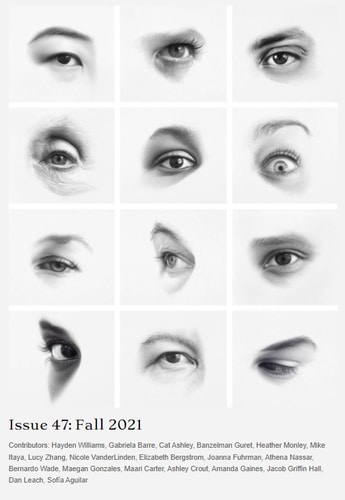 Volumes 40.1 & 40.2 / 2014 of the New Orleans Review are amazing, gorgeous, so super cool and no doubt will be THE collectible edition of the year! As a fan of the unique and quality ephemeral, I nearly swooned when I pulled this out of the stacks – a box set of individual chapbooks in honor of “New Orleans Review’s 45-year history of publishing innovative work from around the world.”
Volumes 40.1 & 40.2 / 2014 of the New Orleans Review are amazing, gorgeous, so super cool and no doubt will be THE collectible edition of the year! As a fan of the unique and quality ephemeral, I nearly swooned when I pulled this out of the stacks – a box set of individual chapbooks in honor of “New Orleans Review’s 45-year history of publishing innovative work from around the world.”
The seven books include: Because You’re Mine by Cassie Condrey, the 2013 Walker Percy Prize in Short Fiction selected by Christine Wiltz; Starbaby Blooms A Tuber Rose by Tessa Fontaine; A is for Afterimage by Christine Hamm; Literature for Nonhumans by Gabriel Gudding; Two Stories by Luis de Lión (tr. Silvia Juarez-Gomez & Nathan C Henne); Circus Freaks by Ana María Shua (tr. Steven J. Stewart); and Wastoid by Mathias Svalina.
The publication can be purchased via the publication’s website – but hurry. Their issues often sell out, and I imagine this one won’t last.
Spread the word!
Ultra-Violence in Literature
 The Missouri Review editor Speer Morgan begins the forward for the Fall 2014 issue themed Ultra-Violence: “Violence in literature and entertainment continues to be debated, and for good reason. One does get tired of it being so casually depicted in every imaginable format, from television and games to novels. However, in this issue of TMR I notice a good measure of violence and pain, reminding me of a truism about this and other subjects in literature—that it all depends on the handling.”
The Missouri Review editor Speer Morgan begins the forward for the Fall 2014 issue themed Ultra-Violence: “Violence in literature and entertainment continues to be debated, and for good reason. One does get tired of it being so casually depicted in every imaginable format, from television and games to novels. However, in this issue of TMR I notice a good measure of violence and pain, reminding me of a truism about this and other subjects in literature—that it all depends on the handling.”
Morgan goes on to discuss Shakespeare and Anthony Burgess, commenting, “Unfortunately, what’s hard to avoid in life becomes a fundamental subject in serious art.” He then introduces the works in this issue, sussing the art of that which we find hard to avoid, various forms of violence we wish not to know, but which, as “handled” by these authors, has much to offer readers.
Spread the word!
The Imagination of Lewis Carroll
The Imagination of Lewis Carroll by William Todd Seabrook is the winner of the Rose Metal Press eighth annual Short Short Chapbook Contest. The book is appealing to the hand and eye, a font and layout with a flavor of Carroll’s nineteenth century. The twenty-four short chapters imaginatively take us through the life of Lewis Carroll and perhaps is a more accurate biography of him than a factual one. Seabrook uses the techniques of Carroll’s own imagination to imagine Carroll’s life of imagination. Continue reading “The Imagination of Lewis Carroll”
Spread the word!
All the Wasted Beauty of the World
The cover image of Richard Newman’s All the Wasted Beauty of the World is “Great Blue Heron of Southern Indiana” by Nick Nihira and the thirty-nine poems are divided into four sections: 1. Summer Spells; 2. Autumn Contrails; 3. Winter’s Bloom; 4. Spring Necromancies. I assumed the poems would be about nature by the cover and title, and the poems would be in a metrical style since the publisher is Able Muse. That is the delightful surprise about poetry and reviewing—as neither was entirely the case. Continue reading “All the Wasted Beauty of the World”
Spread the word!
The TV Sutras
Dodie Bellamy’s The TV Sutras is “inspired text born from a crisis of urban bombardment.” In the tradition of Joseph Smith, Moses, and the oracle at Delphi, Bellamy’s introduction describes a process wherein after a 30-minute yoga DVD and a 20-minute meditation facing the (turned-off) TV, she turns the TV on and begins to receive a transmission. After a break, she describes the scene, then gives her commentary without “irony, cleverness or perfection—or art.” Continue reading “The TV Sutras”
Spread the word!
Vellum
Chelsea Woodard’s poetry collection Vellum was a finalist for the 2013 Able Muse Book Award, judged anonymously by the Able Muse Contest Committee. The forty-six poems are well-balanced with nine to ten poems in each of the five parts, though not grouped by specific theme or setting. Continue reading “Vellum”
Spread the word!
The Long Blue Room
Joan Gelfand searches her own motives with a touch of whimsy while probing for hard answers, which makes her wide knowledge of humanity evident in her book The Long Blue Room. She is a poet who has visited abroad and traveled across her own country to gain a sense of contemporary life grounded in realism but also presented with a delightful wit that’s penetrating and wise. She observes the rhythms, the good and bad about her, but maintains the appreciation of small things—takes time to thoroughly taste fruits like peaches and pears and wonder about them. Continue reading “The Long Blue Room”
Spread the word!
Sisters and Courtesans
Greek dramatists called them “Chorus.” Virginia Woolf christened them “Judith Shakespeare.” In big-budget films with a religious, historic, or fantasy theme, they are “Extras.” On television, they form the zombie army on The Walking Dead or seek fame on reality TV, which is like turning zombie. With the exception of letters and journals written before the Industrial Revolution that survived by luck, there isn’t much to go on. Continue reading “Sisters and Courtesans”
Spread the word!
Sherwood Nation
Benjamin Parzybok’s new novel Sherwood Nation is the latest addition to what is now being called “climate lit.” Books with apocalyptic plots which once seemed so far off in some crazy future are now disturbingly within reach. Recent titles such as Barbara Kingsolver’s “Flight Behavior” and Eden Lepucki’s “California” seem plausible. Continue reading “Sherwood Nation”
Spread the word!
The Wish Book
I was drawn to reading Alex Lemon’s The Wish Book partly from the surreal quality of its cover which features fish floating over a well-dressed bird-headed character while a mustached man reads a newspaper of poems, and a dapper potato-headed figure of many eyes lifts the arm of his suit where a large insect pokes free. Yet there are many contemporary poets who seem to draw surreal dream-like worlds on the page; that alone isn’t enough to make a book stand out for me. Continue reading “The Wish Book”
Spread the word!
Those Who Leave and Those Who Stay
The reader will either become addicted to or lack the commitment needed for Elena Ferrante’s Neapolitan novels starting with My Brilliant Friend (331 pages), followed by The Story of a New Name (471 pages) and this latest third volume Those Who Leave and Those Who Stay. The final fourth volume will come out September 2015. The length of the novels and the character-driven, rather than plot-driven, story might discourage some readers. Continue reading “Those Who Leave and Those Who Stay”
Spread the word!
Lit Mag Covers :: Picks of the Week

This inaugural issue of Profane Literary Journal features “A Feeling of Freedom” by W. Jack Savage, a painting with such rich texture it makes it appear as if the cover is actually canvas.
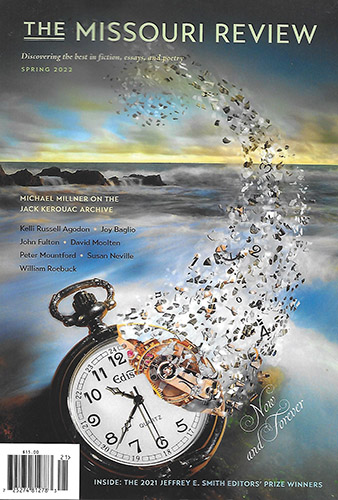
Each time I look at this cover, I can’t help but hear the song “These Boots Are Made For Walkin’.” They’re not boots, actually, but shoes with pant legs, and a crowd of little people as the shadow of each footstep. The piece is Karma by Do Ho Suh (2003; Urethane paint on fiberglass and resin; 153 1/2 x 118 x 291 inches) and is a fitting image for the theme of the Fall 2014 issue of The Missouri Review: Ultra-Violence.
Spread the word!
Giving College Admins What They Deserve
Issue 10 of Saranac Review marks a decade that this annual of the SUNY College at Plattsburgh Department of English and Writing Arts Programs has been publishing. “No easy task,” remarks J.L. Torres in the Editor’s Notes. Torres mentions “then Provost Robert Golden, who secured budgetary support for the journal” in its infancy.
I’m glad Torres names Provost Golden. Such support as this is crucial for an academic publication to survive. A decade or so ago, I heard remarks from independent journal editors about how “easy” academic literary magazines had it because their funding was secure. I knew first hand this wasn’t true. At one college, I founded and led the college’s literary journal, and hoped the fact a key administrator’s daughter was in a creative writing program would offer us some of that mythical security. It did not. The journal was pitted against the outdoor club for an annual scrap of funding, and lost. Seems our administrator enjoyed hiking more than reading.
Then the recession hit, and college administrators nationwide went after every penny they could seize. Literary magazines make easy targets: seemingly “frivolous” and non-essential, especially publishing works those in decision-making roles find difficult to understand, if they read them at all. Numerous times, NewPages went to bat for these threatened publications, writing letters on their behalf to presidents, deans, provosts, and encouraging others to do the same. Yet we watched them fall. (Isotope, I still miss you!)
I listened to the shift in conversation, to editors talking about removing publications from their academic homes in order to save them, to find their own means of secure funding, and to be able to control the content (another long-standing battle that can occur in academic settings). I watched publications move online, either under pressure from an administration that believed this meant the journal would be “free” to publish, or from editors simply trying to save the publication with this less expensive format (usually along with the loss of their stipends, release time, office space, support staff, etc.). This was a risky move since, at that time, online publications were considered suspect in terms of credibility and stigmatized as “lower quality.”
The challenge continues, in this day and age of STEM not only is the focus on science, technology, engineering and math in education, but people in these fields tend to come with deep pockets that can support all kinds of initiatives (like new multimillion dollar campus buildings). Still, I am encouraged by the number of times I see STEAM as the emerging acronym, including “the arts” as being as vitally important to the creative process and on equal ground when it comes to critical thinking and developing the “whole” human being. It is an inclusion and partnering that is essential. The goal now is to continue encouraging and working with those in positions of decision making and power over the purse strings to see the value in the arts as much as those supporters of STEAM do, and as much as we do.
I don’t know former Provost Robert Golden, but he has my respect, as do all chairs, deans, provosts, vice presidents, and presidents who support the arts at their schools – not just in words, but in the cold, hard cash necessary to keep the arts alive and vibrant, as whole and as valid as any other aspect of academic study, professional and human development.
I recently attended the anniversary of a famous American composer who came back to his former college to celebrate with the former college president. I listened to speeches about how the arts were funded and supported at the school. I watched colleagues and community members give this former president a standing ovation. I’m sure he wasn’t a perfect president in his day, but whatever his faults may have been at the time, they hadn’t followed him into the future. I wondered about other college presidents, how they might be remembered years after they retired. I can imagine the Saranac Review having a 10th anniversary celebration and Robert Golden being invited. I can imagine that he, along with those currently in positions of power, would receive a standing ovation for their continued support of the publication.
It’s good to be recognized. If there are those at your college who have shown support in the past and in the present, I hope that you will take the opportunity to recognize them. Have some event where they are invited. Initiate a standing ovation to them. If you’re online, maybe you can find some way to create a virtual standing ovation. It doesn’t mean there haven’t been and won’t be struggles to survive, but don’t let their good efforts go unrecognized. I think those who have not done likewise should know the recognition they’ve lost, the respect they will never experience ten years, twenty years, thirty years later. I have seen that over time, people have not forgotten this good work. Those in positions now should see what they can choose to continue or not, what their own legacy could be.
Spread the word!
Cascadia Poetry Festival 2015
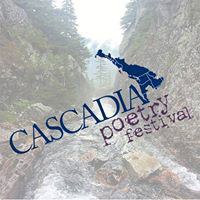 The Cascadia Poetry Festival, the third in an annual festival series that originated in 2012 in Seattle will be held in the Vancouver Island city of Nanaimo, BC, April 30 – May 4.
The Cascadia Poetry Festival, the third in an annual festival series that originated in 2012 in Seattle will be held in the Vancouver Island city of Nanaimo, BC, April 30 – May 4.
Organizers have received a $5000 grant from the Tourism Development Fund of Nanaimo, and a $2500 grant from the Canada Council for the Arts for this festival. In addition to business, organization and individual sponsors, there will be a number of small presses purchasing tables at the festival, and tables are available for reservation.
Entrance is available via Gold Passes at $25.00 for a four-day all events pass (Workshops are separate.), $10.00 for students. There will be four workshops delivered by Canadian and International featured and headliner poets.
The NewPages Writing Conferences & Events Guide this and more conferences, book & literary festivals, workshops and retreats, residencies and writing centers. Check it out!
Spread the word!
Verso Live Jour- nal
 Amsterdam-based Versal literary journal went on “intermission” last year, which Editor Megan Garr soundly defends does not mean the publication is dead. To the contrary, Versal is achieving goals they had set for their downtime (though selling out the back issues is still on the To Do List – which you all could help with!). In a bold step forward and away from their past, Versal has started a super cool new venture: Verso / live jour- nal which “renders the literary journal in live form.” Each curated edition will feature one editor and one writer, and a selection of artists and thinkers in various forms: interviews, essays, slideshows, film, sound, and more. Each live issue is themed and edited: 1.1 “Hold Your Tongue” ed. Megan Garr; 1.2 “A Good Road to Follow” ed. Daniel J. Cecil; 1.3 “Chain Gang” ed. Anna Arov; 1.4 “Bad Dog” ed. Jane Lewty. Such a cool idea, but no surprise coming from Versal!
Amsterdam-based Versal literary journal went on “intermission” last year, which Editor Megan Garr soundly defends does not mean the publication is dead. To the contrary, Versal is achieving goals they had set for their downtime (though selling out the back issues is still on the To Do List – which you all could help with!). In a bold step forward and away from their past, Versal has started a super cool new venture: Verso / live jour- nal which “renders the literary journal in live form.” Each curated edition will feature one editor and one writer, and a selection of artists and thinkers in various forms: interviews, essays, slideshows, film, sound, and more. Each live issue is themed and edited: 1.1 “Hold Your Tongue” ed. Megan Garr; 1.2 “A Good Road to Follow” ed. Daniel J. Cecil; 1.3 “Chain Gang” ed. Anna Arov; 1.4 “Bad Dog” ed. Jane Lewty. Such a cool idea, but no surprise coming from Versal!
Spread the word!
Lit Mag Covers :: Picks of the Week
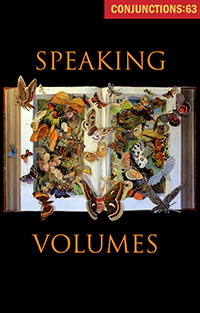
Issue 63 of Conjunctions is themed “Speaking Volumes,” and Kerry Miller’s mixed media piece Brehm Djurens Liv (Animal Life) does just that in its visual imagery.
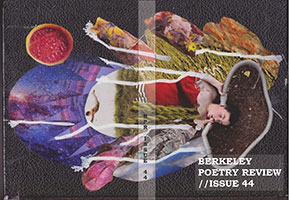
To continue the theme of speaking, subtle ceiling is credited for this cover image on issue 44 of Berkeley Poetry Review. The tumblr account, subtleceling.tumbler.com is credited to carolina, a “mixed media maker of things” from California now in Gotenburg, Sweden. The issue itself features many works that create a “collage of discrepant (and sometimes discordant) voices . . . “
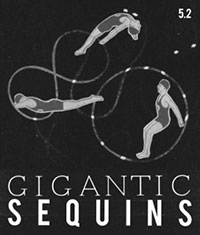
This cover image for Gigantic Sequins #52 seemed a natural flow from BPR. And likewise, a natural from book designer, poet, and artist Meg Willing.

And then this nice, natural flow of images to the cover of Black Warrior Review (Fall/Winter 2014): Nager in Cyan by Summer Johnson. Sometimes, these lit mag cover features just take on a thematic flow of their own.
Spread the word!
Some Literary News Links :: November 11, 2014
The Association for Library Service to Children has release six unique Graphic Novels Reading Lists for K-8.
Mitch Kellaway of The Advocate offers his list of The Year’s 10 Best Transgender Non-Fiction Books: Trans non-fiction writing has had a banner year, exploring love, sexuality, and family in deep and refreshing ways.
Apply by Dec 30 to win $3000 to promote your library from the Campaign for America’s Libraries.
Landon MacDonald of USC’s The Daily Trojan sleuths the truth about Sherlock Holmes and the curious case of expired copyright.
Major New Prize for African Literature Announced recognizing excellent writing in African languages and encouraging translation from, between and into African languages.
From the BBC’s iWonder website Writing the Future: A Timeline of Science Fiction Writing.
The University of Iowa has undertaken to digitize science fiction fanzines from the James L. ‘Rusty’ Hevelin Collection of almost 10,000 fanzines.
Spread the word!
Coffee House Press Allan Kornblum
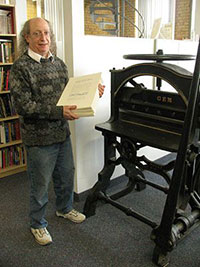 We were saddened to hear the news today that Coffee House Press founder Allan Kornblum has passed away. NewPages writer Jessica Powers interviewed Allan back in 2006: “The impulse to publish is the impulse to share enthusiasm.” We shared this impulse and enthusiasm with Allan for decades. We will miss him dearly. We will all miss him dearly.
We were saddened to hear the news today that Coffee House Press founder Allan Kornblum has passed away. NewPages writer Jessica Powers interviewed Allan back in 2006: “The impulse to publish is the impulse to share enthusiasm.” We shared this impulse and enthusiasm with Allan for decades. We will miss him dearly. We will all miss him dearly.
Spread the word!
American Short Fiction Contest Winner
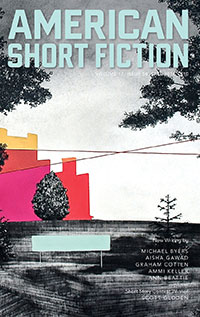 The Fall 2014 issue of American Short Fiction features Scott Gloden’s “What Is Louder,” the winning entry of the American Short Fiction Contest. His same story had been awarded second place in the Glimmer Train March 2014 Family Matters Contest.
The Fall 2014 issue of American Short Fiction features Scott Gloden’s “What Is Louder,” the winning entry of the American Short Fiction Contest. His same story had been awarded second place in the Glimmer Train March 2014 Family Matters Contest.
Gloden’s story is about a man who works in a post office and his brother who is soldier in Pakistan. Contest judge Amy Hempel praised the story for its new territory, commenting, “the ending is unnerving, very unsettling, and continues the story in a reader’s imagination.”
An excerpt: “My brother tells me that the bombs don’t look like they did on television when we were young: they’re not bowling balls with wick spouts that fire out like a sparkler. Instead, they’re clock radios; they’re wads of Silly Putty with electromagnetic current running through sparse wires; they’re ramshackle, he even said—so much so, a bomb looks more like something you store in the garage, which you don’t need every day but keep around in case of emergencies.”
Winners of the American Short Fiction prize receive $1000 and publication.
Spread the word!
Hudson Review New Writers Issue
 The newest issue of The Hudson Review (Autumn 2014) is their New Writers Issue and features essays by Mara Naselli, James Santel, fiction by Asako Serizawa, Edward Porter, Lauren Schenkman, and poetry by Cally Conan-Davies, William Louis-Dreyfus, Trent Busch, Katherine Robinson, Guillermo Bleichmar, Anne Nance, and Susan de Sola. Some of the works can be read in full on the journal’s website.
The newest issue of The Hudson Review (Autumn 2014) is their New Writers Issue and features essays by Mara Naselli, James Santel, fiction by Asako Serizawa, Edward Porter, Lauren Schenkman, and poetry by Cally Conan-Davies, William Louis-Dreyfus, Trent Busch, Katherine Robinson, Guillermo Bleichmar, Anne Nance, and Susan de Sola. Some of the works can be read in full on the journal’s website.
Spread the word!
Joseph Bathanti Gives MSR the Answers
 M. Scott Douglass, publisher and editor of Main Steet Rag, is one of the most doggedly and passionately persistent people I know, especially when it comes to poetry. His efforts turned a bit more political this past year with the controversy surrounding the annual appointment of North Carolina’s Poet Laureate. In Scott’s words:
M. Scott Douglass, publisher and editor of Main Steet Rag, is one of the most doggedly and passionately persistent people I know, especially when it comes to poetry. His efforts turned a bit more political this past year with the controversy surrounding the annual appointment of North Carolina’s Poet Laureate. In Scott’s words:
“In Mid-July, North Carolina Governor Pat McCrory bypassed the established protocol for selecting [former Poet Laureate Joseph Bathanti’s] replacement in the position of NC Poet Laureate. An internet donnybrook ensued because his selection seemed out of touch with the state’s writing community. A spokesperson from the governor’s office said the position was largely symbolic, didn’t require qualifications, and called those who were complaining ‘elitists.’ The governor’s selection for Poet Laureate then resigned. No replacement has been named. National news was made.”
It turns out that Lisa Zerkle had just finished an interview with Bathanti for this issue of MSR during the news of this controversy, but said Bathanti didn’t seem ready to talk about it yet. Scott would not be deterred when he later saw Bathanti would be speaking publicly on the issue. He attended the meeting, asked his own questions, then ask Bathanti if he would be willing to do a follow up on the issue with Zerkle. Bathanti agreed, and the resulting interview is published in this issue, with several pages devoted to the governor’s treatment of the role of Poet Laureate.
